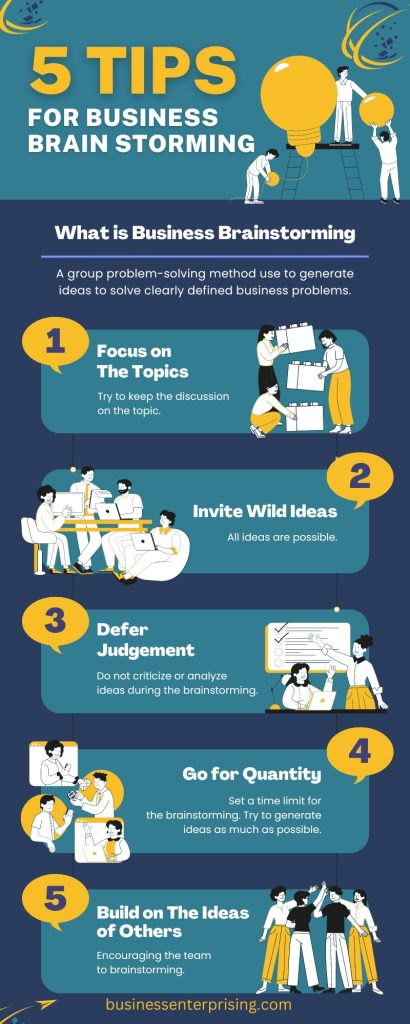Effective brainstorming is a cornerstone of innovation in any business. Incorporating the right Tips for Business Brainstorming can lead to creative solutions, new product ideas, and enhanced team collaboration. Whether you’re launching a new project or looking to solve a persistent challenge, structured brainstorming is key to sparking ideas that move your business forward. It fosters an environment where team members feel comfortable sharing their thoughts, leading to fresh perspectives and innovative strategies. Implementing specific techniques to guide the brainstorming process can make all the difference in achieving actionable results.
Setting the Right Environment for Brainstorming
One of the most important Tips for Business Brainstorming is creating the right environment for your team. A comfortable, open atmosphere encourages creativity and participation. Choose a space where participants can feel relaxed, whether in a traditional meeting room, a collaborative workspace, or even virtually. It’s important to minimize distractions, such as phones or unrelated tasks, so that everyone remains focused on the session.
In addition, creating an atmosphere where everyone feels heard is essential. If team members fear judgment or criticism, they may hesitate to share their ideas. Establishing ground rules that emphasize respect and constructive feedback helps foster open communication. By allowing ideas to flow freely without immediate critique, you encourage participants to explore more creative solutions. A supportive environment nurtures innovation and collaboration.
Encourage Diverse Perspectives
Another key to successful brainstorming is ensuring diverse perspectives are represented. Teams composed of individuals with different backgrounds, experiences, and skill sets often generate more innovative ideas. When assembling a brainstorming team, consider including members from various departments or roles. This diversity brings unique viewpoints and ensures that you approach the problem from multiple angles.
Incorporating diversity into brainstorming also involves encouraging all voices to contribute. Introverted team members may need more encouragement to participate, while more outspoken individuals may dominate the conversation. To address this, one useful Tip for Business Brainstorming is to use structured methods like round-robin brainstorming, where each person is given an opportunity to share. This helps ensure that no ideas are overlooked and that quieter team members have a chance to contribute equally.
Use Structured Brainstorming Techniques
In addition to creating the right environment, applying structured brainstorming techniques helps guide discussions and generate more targeted ideas. One effective method is mind mapping, where participants visually organize their ideas around a central concept. This method encourages free association and allows the group to explore ideas in-depth. Another approach is the “Six Thinking Hats” technique, where participants analyze a problem from different perspectives, such as optimism, caution, or creativity.
Another popular technique is “brainwriting,” where participants write down their ideas silently before sharing them with the group. This approach helps eliminate groupthink, where dominant opinions may influence others. Silent brainstorming allows participants to develop ideas independently before discussing them. These structured methods prevent the brainstorming session from becoming unfocused, ensuring that the conversation stays productive and that every idea is considered.
Prioritize Ideas and Action Steps
While brainstorming often results in a wide range of ideas, the next step is narrowing down those ideas into actionable strategies. One of the best Tips for Business Brainstorming is to categorize and prioritize ideas after the session. This can be done through group voting or by evaluating each idea based on feasibility, impact, and alignment with business goals.
Once you prioritize the ideas, translate them into clear action steps. Assign responsibilities and timelines to implement the most promising ideas. Without follow-up, even the best ideas can fall by the wayside. Establishing accountability within the team ensures that brainstorming sessions lead to tangible results, rather than remaining theoretical exercises.
Foster a Culture of Continuous Brainstorming
Finally, one of the most valuable Tips for Business Brainstorming is fostering a culture of continuous brainstorming. Successful businesses don’t wait for quarterly meetings to solve problems—they encourage ongoing ideation. Create regular opportunities for employees to share their thoughts, whether through suggestion boxes, weekly huddles, or informal brainstorming sessions. By fostering a culture where brainstorming is a regular part of the workflow, businesses can stay agile, proactive, and innovative.
Encouraging a culture of brainstorming also means rewarding creativity and innovation. Recognizing employees for their contributions, whether by celebrating their ideas in meetings or offering tangible rewards, reinforces the importance of creativity within the company. It also motivates team members to continue participating and sharing new ideas. Ultimately, businesses that integrate brainstorming into their everyday practices are more likely to adapt to changing market conditions and stay ahead of competitors.
Effective brainstorming is critical to unlocking creative solutions and fostering innovation. By following these Tips for Business Brainstorming, companies can create an environment where diverse perspectives thrive, structured techniques guide discussions, and innovative ideas turn into actionable strategies. Brainstorming is not just about generating ideas—it’s about creating a culture of continuous improvement and collaboration. When done right, brainstorming strengthens teams, leads to breakthrough solutions, and positions businesses for long-term success.


